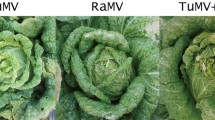Summary
A class of mutants of cauliflower mosaic virus (CaMV) DNA was distinguished based on its members' ability to induce symptoms when coinoculated on plants with other CaMV DNAs mutant at a different locus. Three mutants, one each in open reading frame I, III, and VI had this ability. A second class of mutant DNAs did not induce symptoms unless combined with a mutant DNA of the first class. Viral DNA extracted from diseased plants was shown by restriction enzyme digestion to have lost the mutant alleles. When turnip plants were inoculated with a recombining mutant derived from DNA of the Cabbage S isolate and a mutant derived from DNA of a different isolate, a heterogeneity in the viral DNA extracted from the diseased plants was detected by restriction enzyme analysis. Restriction analysis of cloned representatives of this heterogeneous population revealed regions consistent with repair of heteroduplexes formed during general recombination between duplex DNAs. Some regions consistent with this mechanism or with recombination by strandswitching during reverse transcription were found.
Similar content being viewed by others
References
Armour SL, Melcher U, Pirone TP, Lyttle DJ, Essenberg RC: Helper component for aphid transmission encoded by region II of cauliflower mosaic virus DNA. Virology 129:25–30, 1983.
Balazs E, Guilley H, Jonard G, Richards K: Nucleotide sequence of DNA from an altered-virulence isolate D/H of the cauliflower mosaic virus. Gene 19:239–249, 1982.
Brisson N, Paszkowski J, Penswich JR, Gronenborn B, Potrykus I, Hohn T: Expression of a bacterial gene in plants by using a viral vector. Nature 310:511–514, 1984.
Chang ACY, Cohen SN: Construction and characterization of amplifiable multicopy DNA cloning vehicles derived from the P15A cryptic miniplasmid. J Bacteriol 134:1141–1149, 1978.
Coffin JM: Structure, replication, and recombination of retrovirus genomes: some unifying hypotheses. J Gen Virol 42:1–6, 1979.
Daubert S, Shepherd RJ, Gardner RC: Insertional mutagenesis of the cauliflower mosaic virus genome. Gene 25:201–208, 1983.
Dixon LK, Koenig I, Hohn T: Mutagenesis of cauliflower mosaic virus. Gene 25:189–199, 1983.
Franck A, Guilley H, Jonard G, Richards K, Hirth L: Nucleotide sequence of cauliflower mosaic virus DNA. Cell 21:285–294, 1980.
Gardner COJr, Melcher U, Shockey MW, Essenberg RC: Restriction enzyme cleavage maps of the DNA of two cauliflower mosaic virus isolates. Virology 103:250–254, 1980.
Gardner RC, Howarth AJ, Hahn P, Brown-Luedi M, Shepherd RJ, Messing J: The complete nucleotide sequence of an infectious clone of cauliflower mosaic virus by M13mp7 shot gun sequencing. Nucleic Acids Res 9:2871–2887, 1981.
Gardner RC, Shepherd RJ: A procedure for rapid isolation of cauliflower mosaic viruses. Virology 106:159–161, 1980.
Gelbart WM, McCarron M, Pandey J, Chornick A: Genetic limits of the xanthine dehydrogenase structural element within the rosy locus of Drosophila. Genetics 78:869–886, 1974.
Gronenborn B, Gardner RC, Schaefer S, Shepherd RJ: Propagation of foreign DNA in plants using CaMV as vector. Nature 294:773–741, 1981.
Guilley H, Richards KE, Jonard G: Observations concerning the discontinuous DNAs of cauliflower mosaic virus, EMBO J 2:277–282, 1983.
Hohn T, Pietrzak M, Dixon L, Koenig I, Penswick J, Hohn B, Pfeiffer P: Involvement of reverse transcription in cauliflower mosaic virus replication. In: Robertson HD, Howell SH, Zaitlin M, Malmberg RL (eds) Plant Infectious Agents. Cold Spring Harbor, Cold Spring Harbor Laboratory, 1983, pp 28–33.
Howell SH: Plant molecular vehicles: potential vectors for introducing foreign DNA into plants. Ann Rev Plant Physiol 33:609–650, 1982.
Howell SH, Walker LL, Walden RM: Rescue of in vitro generated mutants of cloned cauliflower mosaic virus genome in infected plants. Nature 293:483–486, 1981.
Hull R: Structure of cauliflower mosaic virus genome III. Restriction endonuclease mapping of thirty-three isolates. Virology 100:79–90, 1980.
Hull R, Covey SN: Replication of cauliflower mosaic virus DNA. Sci Prog Oxf 68:403–422, 1983.
Ish-Horowicz D, Burke JF: Rapid and efficient cosmid cloning vector. Nucleic Acids Res 9:2989–2993, 1981.
Lebeurier G, Hirth L, Hohn B, Hohn T: In vivo recombination of cauliflower mosaic virus DNA. Proc Natl Acad Sci USA 79:2932–2936, 1982.
Maxam AM, Gilbert W: Sequencing end-labeled DNA with base-specific chemical cleavages. Methods in Enzymol 65:499–559, 1980.
Menissier J, Lebeurier G, Hirth L: Free cauliflower mosaic virus supercoiled DNA in infected plants. Virol 117:322–328, 1982.
Miller LK, Cooke BE, Fried M: Fate of mismatched basepair regions in polyoma heteroduplex DNA during infection of mouse cells. Proc Natl Acad Sci USA 73:3073–3077, 1976.
Olszewski N, Hagen G, Guilfoyle TJ: A transcriptionally active, covalently closed minichromosome of cauliflower mosaic virus DNA isolated from infected turnip leaves. Cell 29:395–402, 1982.
Pfeiffer P, Hohn T: Involvement of reverse transcription in the replication of cauliflower mosaic virus: a detailed model and test of some aspects. Cell 33:781–789, 1983.
Walden RM, Howell SH: Intragenomic recombination events among pairs of defective cauliflower mosaic virus genomes in plants. J Mol Appl Genet 1:447–456, 1982.
Walden RM, Howell SH: Uncut recombinant plasmids bearing nested cauliflower mosaic virus genomes infect plants by intragenomic recombination. Plant Molec Biol 2:27–31, 1983.
Woolston CJ, Covey SN, Penswick JR, Davies JW: Aphid transmission and a polypeptide are specified by a defined region of the cauliflower mosaic virus genome. Gene 23:15–23, 1983.
Author information
Authors and Affiliations
Rights and permissions
About this article
Cite this article
Choe, I.S., Melcher, U., Richards, K. et al. Recombination between mutant cauliflower mosaic virus DNAs. Plant Mol Biol 5, 281–289 (1985). https://doi.org/10.1007/BF00020625
Received:
Revised:
Accepted:
Issue Date:
DOI: https://doi.org/10.1007/BF00020625




